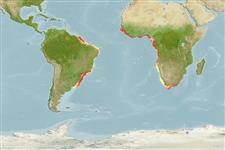Common names from other countries
>
Perciformes/Bembropoidei (Duckbill flatheads) >
Bembropidae (Duckbill flatheads)
Etymology: Bembrops: Greek, bembras, -ados = a kind of anchovy m+ Greek, ops = appearance (Ref. 45335); heterurus: Specific name probably from the Greek 'heteros' meaning different and 'oura' meaning tail..
Environment: milieu / climate zone / depth range / distribution range
Οικολογία
Θαλασσινό(ά) βενθικό(ς); εύρος βάθους 50 - 400 m (Ref. 6948), usually 80 - 200 m (Ref. 47377). Deep-water; 12°N -
Western Atlantic: off Rio de Janeiro, Brazil to Uruguay. Eastern Atlantic: Mauritania to the extreme northern waters of Namibia (Ref. 6948, 27121). The eastern Atlantic form referred to as Bembrops heterurus is unlikely to be conspecific with the Brazilian form, thus further taxonomic study is needed to clarify this situation (Ref. 6948).
Μέγεθος / Βάρος / Age
Maturity: Lm ? range ? - ? cm
Max length : 28.0 cm TL αρσενικό/απροσδιόριστο; (Ref. 6948); common length : 20.0 cm TL αρσενικό/απροσδιόριστο; (Ref. 2683)
Ραχιαίες άκανθες (συνολικά): 6; Μαλακές ραχιαίες ακτίνες (συνολικά): 14-15; Μαλακές εδρικές ακτίνες: 16 - 18. Color in alcohol light yellowish to yellowish brown dorsally, light yellowish brown to creamy brown ventrally. Upper lobe of caudal fin elongated at an acute angle. Snout relatively short, 1.0-1.4x eye diameter. Scales on lateral and dorsal surfaces of snout including area in front of eye. Upper jaw extending behind anterior margin of eye but not reaching its mid-line. Maxillary tentacle short. Lateral line descending gradually along dorsal edge of pectoral fin, separated from origin of first dorsal fin by 4 or 5 rows of scales, from origin of anal fin by 6 or 7, and from insertion of anal fin by 3-5. Pectoral fin moderately rounded. Lower lobe truncate or rounded (Ref 13203).
Found on soft bottoms of the continental shelf and feeds on crustaceans and fishes (Ref. 3656).
Life cycle and mating behavior
Γεννητική Ωρίμανση | Αναπαραγωγή | Γεννοβολία | Αβγά | Γονιμότητα | Προνύμφες
Das, M.K. and J.S. Nelson, 1996. Revision of the percophid genus Bembrops (Actinopterygii: Perciformes). Bull. Mar. Sci. 59(1):9-44. (Ref. 13203)
IUCN Red List Status (Ref. 130435)
CITES (Ref. 128078)
Not Evaluated
Threat to humans
Harmless
Human uses
αλιεία: Εμπορικό(ά)
Περισσότερες πληροφορίες
ΑναφορέςΥδατοκαλλιέργειεςΠροφίλ υδατοκαλλιέργειαςΣτελέχοιΓενετικήElectrophoresesΚληρονομικότηταΑσθένειεςΜεταποίησηMass conversion
ΣυνεργάτεςΦωτογραφίεςStamps, Coins Misc.ΉχοιΣιγκουατέραΤαχύτηταΚολυμβητικός ΤύποςΕπιφάνεια βραγχίωνOtolithsΕγκέφαλοιΌραση
Εργαλεία
Special reports
Download XML
Διαδικτυακές πηγές
Estimates based on models
Preferred temperature (Ref.
115969): 13.9 - 24.3, mean 16.8 (based on 91 cells).
Phylogenetic diversity index (Ref.
82804): PD
50 = 0.5000 [Uniqueness, from 0.5 = low to 2.0 = high].
Bayesian length-weight: a=0.00447 (0.00244 - 0.00818), b=3.08 (2.92 - 3.24), in cm Total Length, based on LWR estimates for this species & (Sub)family-body (Ref.
93245).
Τροφικό Επίπεδο (Ref.
69278): 4.0 ±0.2 se; based on diet studies.
Fishing Vulnerability (Ref.
59153): Low vulnerability (18 of 100).
